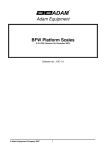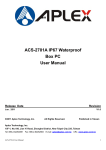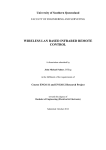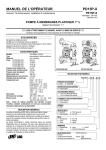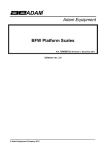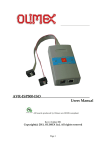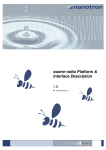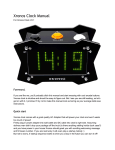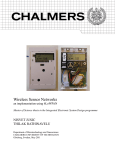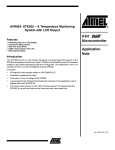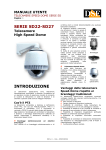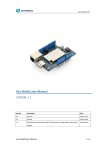Download Goldilocks User Manual
Transcript
Goldilocks User Manual Goldilocks User Manual 18 August 2013 Introduction Arduino Installation Goldilocks Hardware ATmega1284p Features ATmega32U2 Features Layout / Header Pins Solder Bridge Descriptions I2C Arduino PreR3 Support SPI Interconnect Rx Tx Disconnect ATmega32U2 Rx Tx LED Disconnect ATmega32U2 HWB (DFU Bootloader) & ATmega1284p RESET Disconnect Selected Feature Descriptions Prototyping space uSD Card ATmega1284p JTAG Header 32.768kHz Crystal RESET buttons 32U2 Port Header AVR Fuses Power Configuration Arduino Compatibility Features Details Known Arduino R3 Incompatibilities ATmega1284p Firmware Wiring (stk500v2) ATmega1284p Bootloader ATmega32U2 Firmware LUFA DFU Bootloader LUFA Benito (U2duino) Serial Interface Schematic Errata Support Contact Information Support Information Precautions Legal Copyright Notices Software Warranty Disclaimer Phillip Stevens 18 August 2013 Goldilocks User Manual Hardware Disclaimer Trademarks Acknowledgments Phillip Stevens 18 August 2013 Goldilocks User Manual Introduction The Goldilocks is an advanced AVR development PCB loaded with both the ATmega1284p microcontroller and the ATmega32U2 USB microcontroller. Goldilocks is intended to conform to the Arduino Uno or Leonardo physical format and interface standards, bringing significant improvements and longevity into the existing Arduino AVR platform, whilst providing full compatibility with both R3 and preR3 Arduino Shields. Whilst the Goldilocks is easy to use and is designed and built with care, it is not intended to be an entry point into the world of Arduino and microcontrollers in general. The easiest entry point remains the standard Arduino Uno R3, or cloned device. When you find you are being constrained by what your Arduino can do, you should come back to love the Goldilocks. Phillip Stevens 18 August 2013 Goldilocks User Manual The Goldilocks implements many features intended to increase the flexibility of the Arduino platform, allowing advanced projects to be completed, but retaining full compatibility for Arduino Shields to give users access to the full portfolio of options developed for the Arduino Uno and its peers and clones. These features, listed below, will be covered in detail in later sections of this manual. ● Through hole connectors for all I/O pins aligned to 0.1” pitch for breadboard or ribboncable compatibility. ● Prototyping space, with stitched cross connections, aligned to 0.1” pitch, and extended outside standard Arduino Uno shield profile. ● Both ATmega1284p and ATmega32U2 ports pinout available in pin logical order. ● Extra 2 x Analogue and 2 x Digital I/O pins. ● I2C pins replicated near to the prototyping space. ● I2C interconnect option for PreR3 shield compatibility. ● LED indicators located on end outside standard shield profile for unimpeded visibility. ● ATmega1284p clocked at 20 MHz using precision crystal, with option of 22.1184 MHz. ● 32.768 kHz clock crystal for accurate realtime clock timekeeping. ● Independent Analogue ADC Platform, with filtered AVcc supply. ● AREF replicated near Analogue pins for easy offboard usage. ● Access to 3x programmable USART (2x ATmega1284p & 1x ATmega32U2). ● Serial USART disconnect option. ● Independent MCU reset buttons (ATmega1284p and ATmega32U2). ● JTAG (IEEE std. 1149.1 compliant). SEE ERRATA ● Improved PWM pin access. ● SPI interconnect option between ATmega1284p and ATmega32U2, with decoupling. ● Micro SD Card cage using additional SPI Slave Select and Card Detect I/O pins to ensure no impact on existing shield compatibility. SEE ERRATA ● High capacity 7V to 28V Switch Mode Power Supply, specified for 5V 2A. ● 4 layer PCB with industrial grade ground plane and power supply decoupling practices. The 4 layer PCB is high quality with ENIG (gold plated) finish, a gold solder mask, and black screenprinting. The Goldilocks can be powered at 7V to 28V via the 2.1mm barrel connector, or at 5V via USB, depending on the position of the POWER Jumper. Phillip Stevens 18 August 2013 Goldilocks User Manual Arduino Installation Unless you are certain of what you are doing, it is recommended to install the Goldilocks separately from your existing Arduino 1.0.x installations, until you’re sure everything is working as expected. 1. Download and install Arduino version 1.0.5, or greater, from http://arduino.cc/en/Main/Software 2. Download the Goldilocks file from Goldilocks 20130818 (also see Freetronics Goldilocks product page for future support and firmware). 3. Unzip this file into a user directory (ie: My Documents/Arduino). You may need to create this folder. Do not unzip into the arduino system directory from Step 1. 4. Inside there is a directory arduino_goldilocks/ which contains a hardware/ directory. This directory can be placed into the Arduino installation folder you prepared previously. It will ask if you want to replace the boards.txt file, and programmers.txt file, which you should accept. Other files should all be new and will be stored quietly. 5. Start the Arduino IDE, and note that the Goldilocks 20 MHz can be selected in the Board selection menu. Arduino version 1.0.5 supports the addition of the boards.txt and other files directly into your sketch folder. Please refer to the quickstart instructions accompanying the Goldilocks packaging for instruction on this method of adding the necessary files. If you are using Windows, you will need obtain a INF file for the USB Serial interface. As the standard LUFA USB nonclamenture is used, the LUFA U2duino.INF found in the production_firmware folder of the Goldilocks 20130818 file should be installed. Phillip Stevens 18 August 2013 Goldilocks User Manual Goldilocks Hardware ATmega1284p Features The ATmega1284P provides the following features: 128 kBytes of InSystem Programmable Flash with ReadWhileWrite capabilities, 4 kBytes EEPROM, 16 kBytes SRAM, Real Time Counter (RTC), three flexible Timer/Counters with compare modes and PWM, 2 USARTs, one byte oriented 2wire Serial Interface, an 8channel, 10bit ADC with optional differential input stage with programmable gain, one SPI serial port, IEEE std. 1149.1 compliant JTAG test interface, also used for accessing the Onchip Debug system and programming and six software selectable power saving modes. ATmega32U2 Features The ATmega32U2 provides the following features: 32 kBytes of InSystem Programmable Flash with ReadWhileWrite capabilities,1 kByte EEPROM,1 kByte SRAM, two flexible Timer/Counters with compare modes and PWM, one USART, one SPI serial port, debugWIRE interface, also used for accessing the Onchip Debug system and programming and five software selectable power saving modes. Phillip Stevens 18 August 2013 Goldilocks User Manual Layout / Header Pins The below table identifies the layout of the Goldilocks PCB pins with respect to the Arduino Uno R3 board including a comparison of relevant features and provides commentary where relevant. Arduino UNO R3 328p Feature 328p Pin 1284p Pin 1284p Feature Goldilocks Comment Analog 0 PC0 PA0 Analog 1 PC1 PA1 Analog 2 PC2 PA2 Analog 3 PC3 PA3 Analog 4 SDA PC4 PA4 Solder bridge to PC1 SDA I2C Analog 5 SCL PC5 PA5 Solder bridge to PC0 SCL I2C PA6 Analog 6 & Through Hole PA7 Analog 7 & Through Hole Reset Reset PC6 RESET Separate RESET Pin Digital 0 RX PD0 PDO RX0 Digital 1 TX PD1 PD1 TX0 Digital 2 INT0 PD2 PD2 INT0 / RX1 Additional USART1 Rx Digital 3 INT1 / PWM2 PD3 PD3 INT1 / TX1 Additional USART1 Tx Digital 4 PD4 PD4 PWM1 16 bit PWM clear of SPI pins SEE ERRATA Digital 5 PWM0 PD5 PD5 PWM1 16 bit PWM clear of SPI pins Digital 6 PWM0 PD6 PD6 PWM2 Digital 7 PD7 PD7 PWM2 Phillip Stevens 18 August 2013 Goldilocks User Manual Digital 8 PB0 PB2 INT2 Additional External Interrupt Digital 9 PWM1 PB1 PB3 PWM0 Digital 10 SS / PWM1 PB2 PB4 SS / PWM0 SPI Digital 11 MOSI / PWM2 PB3 PB5 MOSI SPI Digital 12 MISO PB4 PB6 MISO SPI Digital 13 SCK PB5 PB7 SCK SPI PB0 uSD Card SPI SS & Through Hole (SEE ERRATA) PB1 uSD Card Card Sense & Through Hole SCL PC0 SCL Separate I2C SDA PC1 SDA Separate I2C PC2 TCK JTAG port PC3 TMS JTAG port PC4 TDO JTAG port PC5 TDI JTAG port XTAL1 PB6 PC6 TOSC1 32.768 kHz RTC Crystal XTAL2 PB7 PC7 TOSC2 32.768 kHz RTC Crystal Phillip Stevens 18 August 2013 Goldilocks User Manual Solder Bridge Descriptions Goldilocks has a number of solder bridge options that are designed to significantly increase the flexibility of the PCB and the use of the two available MCU, and to improve compatibility with existing Arduino shields. I2C Arduino Pre-R3 Support OPEN solder bridges on the rear of the PCB are used to connect the ATmega1284p PC0/PC1 to PA5/PA4 respectively. This for compatibility with Arduino Uno R3, which does not link the I2C SDA/SCL pins with the Analogue 4 and 5 pins. Older (PreR3) shields that have I2C pins on Analogue 4 and 5 are supported by closing the solder bridges. SPI Interconnect The SCK, MISO, MOSI pins on the rear of the PCB are connectable with OPEN solder bridges on the rear of the PCB, to connect the ATmega1284p with the ATmega32U2. Atmel documents AVR151 and AVR910 refer to 1 k ohm to 10 k ohm inseries resistors to prevent SPI bus lockup (but parasitic capacitance effects can limit throughput), to allow an ICSP to function despite the device being in circuit whilst being programmed. Goldilocks is implemented with 1 kOhm resistors in series with the SPI lines to provide this decoupling. The ATmega32u2 PB0 (SS) + PD6 (INT4) pins and the ATmega1284p PB4 (SS) + PB2 (INT2) pins are brought to a row of solder pads on rear of board. The SS lines are aligned to be directly connected. Or alternatively, SS to INTx (or left unconnected) respectively if direct access to either Phillip Stevens 18 August 2013 Goldilocks User Manual SPI Master SS is not desired, but Interrupt signalling the SPI Master is desired. Also, ATmega1284p RESET is provided to allow the optional use of LUFA AVRISP software. Rx Tx Disconnect The Rx Tx Disconnect option is provided for occasions where the user wishes to have all three USART interfaces, on both ATmega1284p and ATmega32U2, available separately. This might be useful where one MCU is controlling a serial interface radio (Zigbee or otherwise), and the other MCU is driving sensors or actuators. Communication between the two MCU can then be done via the SPI bridge, noted above. The Rx Tx bridge is located on the front of the Goldilocks and is normally equipped with resistors. These resistors need to be REMOVED to disconnect the USART interfaces on each MCU. ATmega32U2 Rx Tx LED Disconnect Where the Atmega32U2 is being used as an ancillary MCU and the Digital I/O is in action, it may be necessary to disable the Rx and Tx LEDs if they cause loading on the lines. The Rx Tx disconnect option is located on the rear of the Goldilocks, and is provided to enable a reversible option for this situation. Phillip Stevens 18 August 2013 Goldilocks User Manual ATmega32U2 HWB (DFU Bootloader) & ATmega1284p RESET Disconnect These Arduino standard jumpers on the front of the PCB provide the functionality to put the ATmega32U2 into its DFU bootloader state, to enable programming of the ATmega32U2. The RESETEN separates the ATmega1284p from control of the ATmega32U2. This is useful in the situation where it is NOT desirable that replugging the USB port of the Goldilocks should RESET the ATmega1284p. When this RESETEN solder bridge is separated, it is necessary to press the ATmega1284p RESET button each time it is desired to enter its Wiring (stk500v2) bootloader for reprogramming. Selected Feature Descriptions Prototyping space Prototyping space is provided in one extended section in the upper right of the Goldilocks PCB. On the upper right hand corner a stitched dual row of pins is provided to allow vertically orientated modules to be mounted outside the profile of a standard Arduino Uno sized shield. This space can also be used for conveniently taking signals off the PCB without impacting shield usage. In the centre section six rows of holes are alternately stitched to allow components or small modules to be mounted onto the PCB. Specifically I2C prototyping modules are supported by the provision of the GND, 5V, SCL, and SDA pins along the lower edge of the space. Phillip Stevens 18 August 2013 Goldilocks User Manual uSD Card The micro SD card cage is provided with 3.3V power, and level shifted signals to properly support uSD Cards. The SPI Slave Select line is connected to PB0, which is not allocated to the standard Arduino pinouts, to ensure that full shield flexibility is not compromised. The Card Sense line is connected to PB1. If the standard Arduino SD card library or sketches are used, then the SS pin assignment must be changed to Arduino Digital 14. PLEASE REFER TO ERRATA ATmega1284p JTAG Header The IEEE Standard 1149.1 compliant JTAG header is populated according to the AVR recommendations. JTAG is not enabled by default in the AVR fuse configuration for Goldilocks. 32.768kHz Crystal The ATmega1284p supports Timer2 being driven by an external 32.768kHz watch crystal. Using Phillip Stevens 18 August 2013 Goldilocks User Manual this Timer, together with the avrlibc provided functions in the time.h library allows the creation of an accurate realtime clock capability for the Goldilocks PCB. RESET buttons Two separate RESET buttons are provided for the Goldilocks. The ATmega1284p RESET, located on the lower edge of the PCB, is the “normal” Arduino RESET, and is connected to the RESET pinout. The ATmega32U2 RESET, located on the upper left corner of the PCB, enables the Goldilocks to reset its serial interface without power cycling, or resetting, the ATmega1284p. 32U2 Port Header To make the ATmega32U2 more useful as a “coprocessor” to the ATmega1284p, two complete port pinouts, PB and PD, are provided. These two ports make the SPI bus, the USART, and external interrupt pins available. The ATmega32U2, having 32 kBytes of Flash and 1 kByte SRAM, is nearly as resource rich as the Arduino Uno’s ATmega328p or the Leonardo’s ATmega32U4. It will be possible to develop multiMCU solutions based on the Goldilocks platform, that use the ATmega32U2 to drive a serial device (radio, gps, or gsm, for example), whilst the ATmega1284p manages a complex analogue data acquisition or communications task for example. AVR Fuses The fuses are set slightly differently to the normal Arduino practice. This describes the actual settings on the Goldilocks PCB, for each of the MCU. Both the ATmega1284p and the ATmega32U2 are being operated at their maximum specified system clock. The clock divide by 8, CKDIV8, on both MCU is set to off, so that they can operate at Phillip Stevens 18 August 2013 Goldilocks User Manual this rate. Because of the system clock rate, both MCU require greater than 4.3V for reliable operation. To ensure that the MCU stay in RESET state until their Vcc is adequate the brownout detection level, BODLEVEL, on both MCU is set to 4.3V. Setting the BODLEVEL correctly ensures that the MCU will start immediately, once it is released from RESET. This allows us to reduce the startup time for each MCU to 16k CLK without risk of instability, or need for further delay. Both MCU are driven from Full Swing Oscillators, to further ensure stable operation, as specified by their respective datasheets. In both cases the EESAVE is set to clear the EEPROM each time the MCU is erased, and the system watchdog timer is turned off by setting WDTON off. For the ATmega1284p, the boot reset, BOOTRST, vector is enabled, as we would like the Wiring (stk500v2) bootloader to respond once the MCU is reset. But, both JTAG enable, JTAGEN, and onchip debug, OCDEN, are turned off, as they are advanced features that should be enabled on a case by case basis. For the ATmega32U2, the BOOTRST vector is disabled, as we don’t need the MCU to enter the DFU bootloader, unless we activate the hardware boot pin. This hardware boot enable is set by the hardware boot enable, HWBE, fuse. Phillip Stevens 18 August 2013 Goldilocks User Manual Phillip Stevens 18 August 2013 Goldilocks User Manual Power Configuration Goldilocks can be powered by a variety of options, to provide a 5V supply to the main power. Additionally a 3.3V regulator provides supply for the onboard uSD card and for external shield usage. By default the Goldilocks is powered via 5V USB, with the maximum input current limited to 500mA. By moving the POWER jumper to DC the Goldilocks can be powered from a high current 5V 2A Switch Mode Power Supply, via the 2.1mm (+)ve centre barrel connector. Another option is to provide 5V directly to the Vcc supply rail. Care must be taken not to exceed the maximum voltage rating of the ATmega1284p and ATmega32U2 in this case, otherwise the Goldilocks PCB will be dead. Because both the ATmega1284p and the ATmega32U2 are operated at the maximum system clock frequency specified, their respective brownout fuses are set to ensure that the MCU will not operate until a sufficient supply voltage (4.3V) is available. Phillip Stevens 18 August 2013 Goldilocks User Manual Arduino Compatibility The Goldilocks was designed to be fully compatible with the Arduino R3 standard. In the last year, with the release of ARM platform Arduino boards, the meaning of being fully compatible has become a little greyer and more complex. Hopefully, the Goldilocks reaches the level where it can be considered fully compatible, and possibly being even more “compatible”, with the Arduino legacy, than the Arduino Due. Features The standard Arduino IDE used. The Arduino IDE v1.0.5 was used in development. Prior versions of the IDE provide older versions of the avrlibc that contains some significant bugs. Compatible bootloaders are used in both ATmega1284p and ATmega32U2. Compatible pin mappings are used to ensure that Arduino Uno R3 shields should work as intended, and with some adjustments to the solder jumpers, PreR3 Uno shields will work too. Software development was done on using avrgcc (GCC) 4.7.22 & avrlibc 1.8.03 from Debian Sid repositories on a Ubuntu 12.04 platform. If you are motivated, get a modern avrgcc compiler, such as the gcc 4.7.x branch. The avrgcc 4.3.2 version, included with Arduino IDE v1.0.5 and earlier, is over 5 years old and contains many issues. Support for the ATmegaxxU2 was only added in gcc 4.5.x, for example. Details Over the past years, much work in the core of the avrlibc has been done to support the ATmega1284p. Also, within the Arduino community there has been a push to incorporate the ATmega1284p into standard cores. This means that the Goldilocks can be operated in the Arduino IDE environment with minimal additional information. Purely the boards.txt file is needed to configure the IDE, and also then pins_arduino.h file contained in the variants/goldilocks directory is needed to make sure that the pins are mapped to known Arduino standards. Phillip Stevens 18 August 2013 Goldilocks User Manual ATMEL ATMEGA1284P on Goldilocks Actual implementation with VQFN +\/+ PCINT8 (D14) PB0 1| |40 PA0 (AI 0 / D24) PCINT0 PCINT9 (D15) PB1 2| |39 PA1 (AI 1 / D25) PCINT1 PCINT10/INT2 (D 8) PB2 3| |38 PA2 (AI 2 / D26) PCINT2 PCINT11/OC0A*(D 9) PB3 4| |37 PA3 (AI 3 / D27) PCINT3 PCINT12/0C0B/SS*(D10) PB4 5| |36 PA4 (AI 4 / D28) PCINT4 PCINT13/MOSI (D11) PB5 6| |35 PA5 (AI 5 / D29) PCINT5 PCINT14/OC3A/MISO*(D12) PB6 7| |34 PA6 (AI 6 / D30) PCINT6 PCINT15/OC3B/SCK*(D13) PB7 8| |33 PA7 (AI 7 / D31) PCINT7 RST 9| |32 AREF VCC 10| |31 GND GND 11| |30 AVCC XTAL2 12| |29 PC7 (D23) TOSC2/PCINT23 XTAL1 13| |28 PC6 (D22) TOSC1/PCINT22 PCINT24/RX0 (D 0) PD0 14| |27 PC5 (D21) TDI/PCINT21 PCINT25/TX0 (D 1) PD1 15| |26 PC4 (D20) TDO/PCINT20 PCINT26/INT0/RX1 (D 2) PD2 16| |25 PC3 (D19) TMS/PCINT19 PCINT27/INT1/TX1 (D 3) PD3 17| |24 PC2 (D18) TCK/PCINT18 PCINT28/OC1B*(D 4) PD4 18| |23 PC1 (D17) SDA/PCINT17 PCINT29/OC1A*(D 5) PD5 19| |22 PC0 (D16) SCL/PCINT16 PCINT30/OC2B*(D 6) PD6 20| |21 PD7 (D 7)*OC2A/PCINT31 ++ * = PWM capable pin TOSCn = RTC Crystal pinout (not otherwise available) TCK/TMS/TDO/TDI = JTAG pinout (not otherwise available) Phillip Stevens 18 August 2013 Goldilocks User Manual ############################################################## # # ADD THESE ENTRIES TO YOUR FILE BOARDS.TXT # ############################################################## goldilocks_20MHz.name=Goldilocks 20MHz goldilocks_20MHz.upload.protocol=wiring goldilocks_20MHz.upload.maximum_size=122878 goldilocks_20MHz.upload.speed=38400 goldilocks_20MHz.bootloader.low_fuses=0xd7 goldilocks_20MHz.bootloader.high_fuses=0xd8 goldilocks_20MHz.bootloader.extended_fuses=0xfc goldilocks_20MHz.bootloader.path=stk500v2 goldilocks_20MHz.bootloader.file=stk500boot_v2_goldilocks.hex goldilocks_20MHz.bootloader.unlock_bits=0x3F goldilocks_20MHz.bootloader.lock_bits=0x0F goldilocks_20MHz.build.mcu=atmega1284p goldilocks_20MHz.build.f_cpu=20000000L goldilocks_20MHz.build.core=arduino goldilocks_20MHz.build.variant=goldilocks ############################################################## goldilocks_22MHz.name=Goldilocks 22.1184MHz goldilocks_22MHz.upload.protocol=wiring goldilocks_22MHz.upload.maximum_size=122878 goldilocks_22MHz.upload.speed=38400 goldilocks_22MHz.bootloader.low_fuses=0xd7 goldilocks_22MHz.bootloader.high_fuses=0xd8 goldilocks_22MHz.bootloader.extended_fuses=0xfc goldilocks_22MHz.bootloader.path=stk500v2 goldilocks_22MHz.bootloader.file=stk500boot_v2_goldilocks_22.hex goldilocks_22MHz.bootloader.unlock_bits=0x3F goldilocks_22MHz.bootloader.lock_bits=0x0F goldilocks_22MHz.build.mcu=atmega1284p goldilocks_22MHz.build.f_cpu=22118400L goldilocks_22MHz.build.core=arduino goldilocks_22MHz.build.variant=goldilocks Phillip Stevens 18 August 2013 Goldilocks User Manual Known Arduino R3 Incompatibilities Mounting holes are set to be 2mm in diameter (M2). The Arduino standard is 3mm (M3). The hole size needed to be reduced to allow Port A pins to be continuous. PWM supported pins on the ATmega1284p are different to the Arduino Uno ATmega328p. This means that shields requiring the use of PWM (such as motor Hbridge shields) may need to have the pins rerouted either on the Goldilocks, using the provided pinout options, or on the shield itself. This issue also affects the Arduino Leonardo ATmega32U4. The actual PWM support is better than in the Arduino Uno as the important 16 bit Timer pins, that can generate correct servo timing pulses, are not located on the SPI pins. Also the ATmega1284p has an extra 16bit timer, Timer3, that can also be used for PWM servo control too, allowing 4 servos to be directly controlled. USART serial port speed accuracy and mismatch remains a concern. An acceptable compromise has been provided by implementing the correct calculation for serial baud rate contained in avrlibc util/setbaud.h. However, the total error in serial rate between the AVR MCU at 16 MHz (ATmega32U2) and at 20 MHz (ATmega1284p) unfortunately remains quite high. The Wormfood AVR Serial Rate Calculator indicates the issue with getting an accurate baud rate from a 16 MHz ATmega MCU. If serial communications proves an issue for you, the easy answer is to reduce the ATmega1284p USART to 38,400 baud which provides the lowest differential error (at a reasonably fast communication rate). The ATmega32U2 will auto configure to match the baud rate of your attached terminal programme. Alternatively, the best solution is to operate the ATmega1284p at a USART friendly system clock of 22.1184 MHz, 18.432 MHz, or lower. Because of the issues with serial communications, and the inability of the 16 MHz ATmega32U2 to generate an accurate USART baud rate at either 115,200 or 57,600, the stk500v2 bootloader on the ATmega1284p has been set to operate at 38,400 baud. This does not reduce the actual programming speed for sketches or programmes, but it does allow the total mismatch in baud rates between the two MCU to remain less than 1%. Phillip Stevens 18 August 2013 Goldilocks User Manual ATmega1284p Firmware Wiring (stk500v2) ATmega1284p Bootloader To access the ATmega1284p bootloader monitor open up a serial port at 38,400 baud and type "!!!" within 3 seconds of RESET. The ATmega1284p then enters the stk500v2 "Bootloader>" prompt, which is a useful sekret feature. If you want to see what is actually programmed into the Goldilocks, then this feature allows you to examine the Flash, and EEPROM. It also allows you to see which Vectors have been programmed and to test the hardware by blinking ports. The bootloader commands are: ● 0 Reset address (RAM, EEPROM, FLASH) counters to zero. ● ? CPU stats ● @ EEPROM test ● b Blink LED ● e Dump EEPROM ● f Dump FLASH ● h Help ● l List available I/O Ports ● q Quit and jump to user program ● r Dump RAM ● v show interrupt Vectors ● y Port blink Phillip Stevens 18 August 2013 Goldilocks User Manual ATmega32U2 Firmware The ATmega32U2 firmware was extracted directly from a snapshot from the 130313 release of the LUFA repository. The snapshot was taken on May 20th, but it differs negligibly from the standard release. The choice to use standard LUFA code (with a minimum of divergence) was taken to ensure that the Goldilocks platform would continue to benefit from Dean Camera’s code development efforts and bug fixes. The current Arduino releases of xxU2 code were forked from LUFA in 2010, and haven’t been significantly maintained since then. LUFA DFU Bootloader The DFU bootloader used in the ATmega32U2 is unchanged from the standard maintained by LUFA. Information relating to this code can be found on the LUFA repository. LUFA Benito (U2duino) Serial Interface The LUFA project Benito was used as the basis for the USB to Serial interface for the Goldilocks. The code has been renamed U2duino, and slightly modified to support the wiring or arduino bootloader DTR reset functionality. The project name U2duino was chosen because the code is for xxU2 on the xxduino board, or alternatively the project does: USB2Arduino. The key difference from Benito is the pin driving the ATmega1284p RESET line is toggled OUT_HIGH to OUT_LOW (rather than TRISTATE to OUT_LOW). This ensures that a clear negative edge is generated (via a serial capacitor) on the DTR signal, which properly resets the ATmega1284p. Another key difference is to modify the calculation for USART baud rate to be the same as in the avrlibc file util/set_baud.h file. This calculation method is more correct than the calculation method used in the AVR datasheet. Phillip Stevens 18 August 2013 Goldilocks User Manual Schematic Phillip Stevens 18 August 2013 Goldilocks User Manual Errata ● ● ● ● ● ATmega1284p if the serial port Tx in use, the serial bootloader won’t function, because avrdude stk500v2 protocol doesn’t see the response bytes it expects, and you may be using it at a different rate. An inherent serial bootloader issue. ATmega32u2 used Atmel USB descriptors (rather than Freetronics). But Atmel descriptors have a standard CDC INF file for Windows. The uSD card frame Slave Select SS, is not connected to PB0 (Digital 14) as per design, but rather to the normal Arduino Digital 4 (PD4).This impacts the use of 16bit PWM (found on PD4 and PD5) when the SD card is in use. This also impacts the use of multiple SD cards, as the Goldilocks SD card SS line is now shared with the standard Arduino layout. The uSD card detect line is connected to a through hole close to the rear of the uSD card cage. It is not otherwise connected to any pin, as it is not normally used. If it is required, then jumper from the through hole to a digital pin of your choice. The JTAG VREF pin is not connected. It should nominally be connected to the MCU supply reference voltage of 5V. This should not affect the use of the JTAG connector. Support Contact Information I can be contacted via: twitter @fei_li_pu blog feilipu.me sourceforge https://sourceforge.net/projects/avrfreertos/ Support Information If you have received a Goldilocks because you made pledge on Pozible, please contact me as above, or via a message on the Goldilocks Pozible Project. If you purchased a Goldilocks from Freetronics, or from any distributor reselling the Goldilocks, please contact Freetronics via their support forum. Precautions WARNING Care must be taken when configuring the solder jumpers. It is possible to cause permanent damage to the device or the power supply by improperly setting the jumpers. Do not change any jumpers while the unit is powered. When using the onboard SMPS regulator to power the Goldilocks, be sure not to exceed the specified maximum current output. Phillip Stevens 18 August 2013 Goldilocks User Manual CAUTION The Goldilocks PCB contains static sensitive components. Use the usual ESD procedures when handling. CAUTION Improper fuse settings may result in an unusable Goldilocks PCB. Be certain that you know the effects of changing the fuses, that you understand the convention used for describing the state of the fuses (programmed = 0), and that you are using an appropriate programming speed before attempting to change fuse settings. Legal Copyright Notices This code uses the LUFA USB library Copyright (C) 2013, Dean Camera (www.fourwalledcubicle.com) and distributed under a modified MIT license (see files). The Benito Project and DFU bootloader are modified versions from LUFA 130313. Portions of this code are copyright © 20032013, Atmel Corporation (http://www.atmel.com/) Software Warranty Disclaimer The author disclaim all warranties with regard to this software, including all implied warranties of merchantability and fitness. In no event shall the author be liable for any special, indirect or consequential damages or any damages whatsoever resulting from loss of use, data or profits, whether in an action of contract, negligence or other tortious action, arising out of or in connection with the use or performance of this software. Hardware Disclaimer This development board is intended for use for FURTHER ENGINEERING, DEVELOPMENT, DEMONSTRATION, OR EVALUATION PURPOSES ONLY. It is not a finished product, and may not (yet) comply with some or any technical or legal requirements that are applicable to finished products, including, without limitation, directives regarding electromagnetic compatibility, recycling (WEEE), FCC, CE, or UL (except as may be otherwise noted on the board). I, Phillip Stevens, have supplied this board AS IS, without any warranties, with all faults, at the buyer's and further users' sole risk. The user assumes all responsibility and liability for proper and safe handling of the goods. Further, the user indemnifies me, Phillip Stevens, from all claims arising from the handling or use of the goods. Due to the open construction of the product, it is the user's responsibility to take any and all appropriate precautions with regard to electrostatic Phillip Stevens 18 August 2013 Goldilocks User Manual discharge and any other technical or legal concerns. The product described in this document is subject to continuous development and improvements. All particulars of the product and its use contained in this document are given by me in good faith. However all warranties implied or expressed including but not limited to implied warranties of merchantability or fitness for particular purpose are excluded. This document is intended only to assist the reader in the use of the product. I, Phillip Stevens, shall not be liable for any loss or damage arising from the use of any information in this document or any error or omission in such information or any incorrect use of the product. Trademarks AVR® is a registered trademark of Atmel Corporation. All other trademarks are the property of their respective owners. Acknowledgments Thanks to Dean Camera (http://www.fourwalledcubicle.com/) for his excellent LUFA library and DFU bootloader, which are used in the Goldilocks firmware. Thanks to Pozible for providing their crowdfunding platform. Thanks to those who have previously used the ATmega1284p or ATmega644 in Arduino projects and have smoothed the way for incorporating my Goldilocks into the Arduino family of options. Finally, thanks to Jon Oxer for helping me realise this Goldilocks project, and graciously accommodating my harping and feature creep over the four months of project realisation. Phillip Stevens 18 August 2013


























